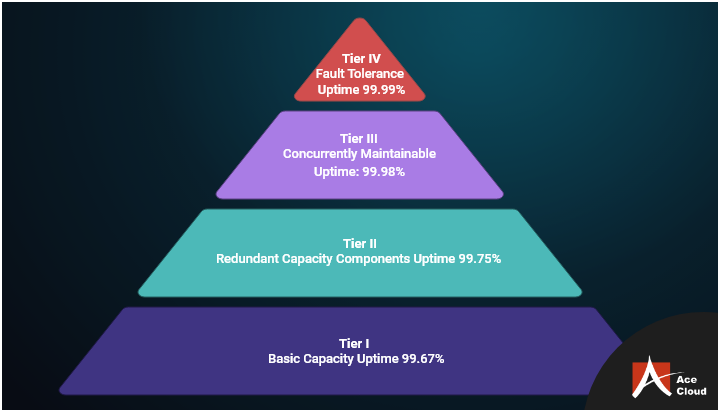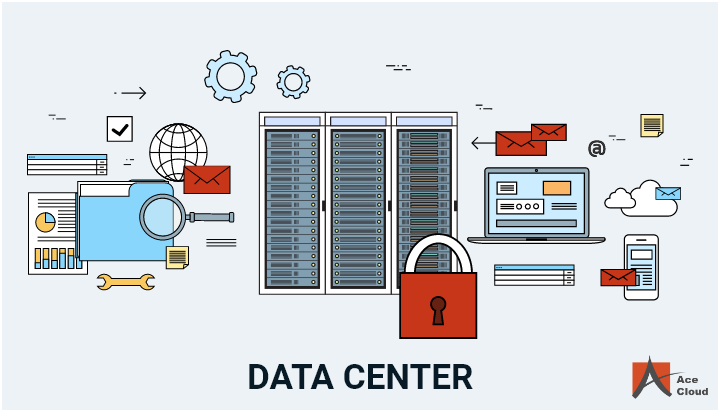A data center is a physical location that houses computing equipment and related hardware, including servers, data storage drives, and network devices.
It serves as a critical infrastructure for IT systems and acts as a centralized location for storing, processing, and managing digital data for businesses and organizations.
Simply, the data center is a critical component of modern IT infrastructure responsible for providing a secure and controlled environment to house applications and services and managing the data associated with those applications and services.
Ace Cloud Hosting’s VDI gives you secure cloud desktops hosted in top-tier data centers, with none of the maintenance overhead.
What is a Cloud Data Center?
In a cloud data center, the physical infrastructure is owned and managed by a third-party service provider, who is responsible for installing, updating, maintaining, and meeting service-level agreements for the infrastructure under their control, enabling organizations to focus on their core business activities, rather than managing their IT infrastructure.
Data centers have undergone a significant transformation in recent years, moving away from traditional on-premises facilities to remote facilities or networks of facilities owned by cloud service providers. Cloud data centers are a modern solution to the challenges of managing IT infrastructure.
Unlike traditional on-premises data centers within an organization’s office, cloud data centers exist virtually on the cloud. This implies that all the data and infrastructure is located off-site and accessed through the Internet rather than physically housed within the organization’s premises. This model is particularly advantageous for data warehouse consulting services, as it facilitates seamless access to large datasets and robust data management capabilities.

The cloud data center makes computing, storage, network, and other applications available on-demand through API and web interfaces, using frameworks such as Infrastructure as a Service (IaaS), Software-defined networking (SDN), Platform as a Service (PaaS), Desktop as a Service (DaaS) and others.
Virtualization in Data Centers: How is it Important?
Over the past two decades, IT organizations have faced an increasingly complex and costly data center environment. The traditional approach of adding new technologies to meet business needs has resulted in data centers that need to be more well-planned, siloed, and better managed.
Today’s data centers in cloud computing are much more than just physical structures. They have evolved into dynamic collections of cloud and non-cloud resources that are spread across multiple locations and can be dynamically orchestrated to process applications efficiently.
This represents cloud data centers, which are designed to be simplified, adaptive, and responsive, allowing IT to focus on innovating business solutions instead of maintaining systems. Several key capabilities characterize this new data center paradigm.
- First, it is a software-defined environment where IT resources are orchestrated holistically and dynamically, responding in real-time to application demands.
- Second, it is a hybrid environment where private and public clouds can work seamlessly with traditional systems, providing maximum flexibility and agility.
- Third, it is a continuously available environment that can withstand component failures and maintain operations, ensuring critical applications are always accessible.
The cloud data center also leverages cognitive computing to solve business problems using advanced analytics. This lets the system adapt to changing business requirements, enhancing efficiency and flexibility.
Virtualization is a key component of SDDCs, as it allows for creation of virtual machines (VMs) that can be managed more efficiently than physical servers.
Types of Data Centers: Enterprise, Public, and Colocation
There are various types of data center facilities, and a single company may use multiple types depending on their workloads and business needs.
Enterprise Data Centers:
An enterprise data center is a centralized facility where an organization’s computing and storage resources are located, managed, and controlled. These data centers typically house servers, storage devices, networking equipment, and other infrastructure required to support IT operations.
Enterprise data centers are designed to meet the needs of large organizations, such as corporations, government agencies, and universities. They typically have high-capacity power and cooling systems, redundant networking connections, and robust security measures to ensure the availability and reliability of their services.
Cloud Data Centers:
Cloud data centers are a type of data center that provides infrastructure, platforms, and software as a service over the Internet. Cloud data centers are operated and maintained by third-party providers, who offer their services to organizations and individuals on a subscription basis.
Cloud data centers offer a variety of hosting options, including:
- Infrastructure as a service (IaaS): IaaS providers use these to host virtual machines, storage, and networking resources, authorizing their users to build and run their own applications
- Desktop as a service (DaaS): Providers use these data centers to host and manage the virtualized computing resources they offer customers.
- Platform as a service (PaaS): Users can rent a pre-configured platform to build and deploy their applications, often with additional tools and services provided by the cloud data center provider.
- Software as a service (SaaS): Users access and use software applications hosted by the cloud data center provider without needing to install or manage the software themselves.
Read More – SaaS vs. PaaS vs. IaaS
Colocation Data Centers:
Colocation data centers offer a physical location for organizations to house their own IT infrastructure.
In a colocation arrangement, the data center provider offers power, cooling, physical security, and network connectivity, while the organization provides its own servers, storage, and networking equipment.
The data center provider is responsible for the facility’s infrastructure, while the organization manages and maintains its own IT equipment.
Architecture of a Data Center
The modern data center in cloud computing has come a long way from traditional IT architecture.
Virtualization and cloud computing have revolutionized how physical hardware resources, such as CPUs, storage, and networking, are utilized in data centers. By abstracting these resources from their physical constraints and pooling them into a shared capacity, organizations can efficiently allocate them across multiple applications and workloads in any required quantities.
This powerful combination of cloud architecture and software-defined infrastructure (SDI) provides numerous benefits to data centers and their users. With SDI, companies can optimize their resource utilization, serving the most users with the least amount of hardware and minimizing unused or idle capacity.
According to a report by VMWare, virtualization reduces overall IT costs by up to 50% through server consolidation, reducing hardware costs and power consumption.
Read More – DaaS a cost effective infrastructure for workspaces
SDI Automation and Rapid Deployment
Software-defined infrastructure (SDI) automation has simplified the provision of new infrastructure, enabling businesses to request and deploy applications and services quickly through a self-service portal. With this streamlined approach, SDI automation reduces time-to-market for businesses, enabling them to launch new products and services faster. This increased efficiency ultimately results in improved business agility and competitiveness.
Gartner predicts, “By 2025, 70% of organizations will implement structured infrastructure automation to deliver flexibility and efficiency, up from 20% in 2021.”
Cloud-Native Development
Containerization and serverless computing, along with a robust open-source ecosystem, enable and accelerate DevOps cycles and application modernization and enable develop-once-deploy-anywhere apps. The shift to cloud architecture and SDI automation has revolutionized how data centers operate.
The benefits of virtualization and cloud computing are evident in the form of optimized resource utilization, rapid deployment of applications and services, scalability, flexibility, and a range of service and data center solutions. With cloud-native development and containerization, data centers are poised to take advantage of even greater efficiency and agility in the coming years.
An Overview of Data Center Security Tiers
Data center security is critical for any business dealing with sensitive information. With cyber-attacks becoming increasingly common and sophisticated, ensuring that the data center where your data is stored has proper security measures in place is essential. This is where data center security tiers come into play.
Data center security tiers are standardized systems used to describe the security and reliability of a data center facility. The tiers are based on a series of criteria established by the Uptime Institute. The Uptime Institute is an organization that provides consulting, certification, and education services to data center owners and operators.

There are four tiers of data center security, with Tier 1 being the lowest and Tier 4 being the highest. Each tier corresponds to a specific level of security and reliability, with Tier 4 being the most secure and reliable.
Tier 1
This is the lowest and most basic tier of data center security. Tier 1 data centers are generally used by small businesses and for non-critical applications. These data centers do not have redundant components, and uptime is guaranteed at around 99.671%. This equates to approximately 28.8 hours of downtime per year.
Tier 2
This tier level is mainly used by businesses that require colocation services. Tier 2 data centers offer some redundancy but still rely on a single source of power and cooling. Uptime is guaranteed at around 99.741%, which equates to approximately 22 hours of downtime per year.
Tier 3
Tier 3 data center security is a significant step from Tiers 1 and 2.The primary difference is that Tier 3 data centers use dual power and cooling resources, providing redundancy and failover capabilities. This redundancy ensures that customers will not experience downtime during maintenance or if one resource fails. Tier 3 offers a 99.982% uptime guarantee, which equates to only 1.6 hours of possible downtime per year.
Tier 4
Tier 4 data center security is the highest level and is ideal for large enterprises that require guaranteed uptime. Tier 4 data centers provide fault tolerance against downtime by offering redundancy on all resources. Customers rarely experience downtime with Tier 4 data centers, which provide a 99.99% uptime guarantee. This equates to only 26.3 minutes of possible downtime per year. Businesses must understand the different tiers and choose a data center that meets their security and uptime needs.
With Ace Cloud Hosting’s VDI, your desktops run on resilient, high-security data centers—ensuring uptime, compliance, and peace of mind.
Leverage Tier 3+ and Tier 4- Data Center Secure with ACE Cloud Hosted Desktops
ACE is committed to delivering an end-to-end software-defined environment that enables greater control and automation of IT with the Tier 3+ and Tier 4- data centers.
Our focus on heterogeneous environments, workload-aware infrastructures, pattern-driven automation, cross-domain integration, and analytics-enabled optimization has enabled us to develop a deep understanding of what is required for this new era of IT infrastructure.
Our commitment to open standards and the use of emerging technologies has allowed us to break down technology barriers and deliver on the promise of the next-generation data center.
With ACE’s solutions and vision, businesses can transform their static IT infrastructure into a dynamic, workload-aware infrastructure that can anticipate demands and respond with incredible speed.

